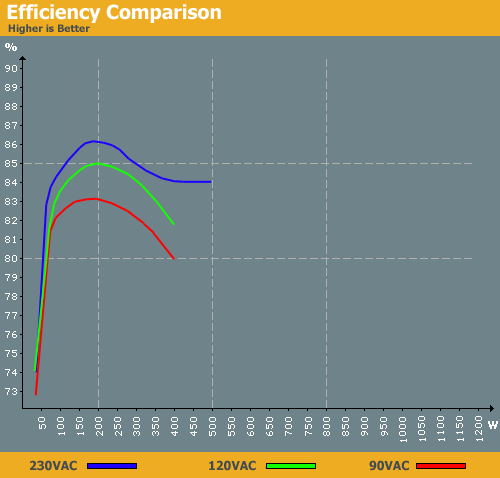Amacrox Calmer 560: Silence is Golden
by Christoph Katzer on April 2, 2008 12:00 AM EST- Posted in
- Cases/Cooling/PSUs
Efficiency and Temperatures

The graph above shows the actual efficiency at the specific wattage output of the unit. With 230VAC the efficiency is higher as usual, reaching slightly more than 86% at around a 190W load. The 85% efficiency at the same load is also fine for users in the US. We would not plan to load this power supply with more than ~200W anyway, since the voltages begin to drop beyond that point. Since we have only few connectors, though, most users won't connect enough components to pull higher wattages.
Unfortunately, all of our thermometers are broken right now, so we can only provide a subjective analysis. Throughout the test, the unit wasn't much more than hand-warm and only rose with higher loads and increasing room temperature. It was never reaching a hot state in which we wouldn't touch it anymore with bare hands. We expect some of the internal temperatures were higher, of course. The Calmer 560 didn't produce any acoustic noise at any time of the test, making this a completely silent power supply.










13 Comments
View All Comments
Super Nade - Wednesday, April 2, 2008 - link
Interesting concept though. I wonder how this will hold up with an 80mm fan?yyrkoon - Wednesday, April 2, 2008 - link
I use the Antec EarthWATTS 500 which also uses a 80mm fan, and i works fine. Matter of a fact the fan is barely audible most of the time.I do have do agree with the OP here though. At first I thought he/she was referring to the outside of the PSU, which I think does not look bad(except that ugly red button). The innards of this thing looks like it was put together by preschool children with construction paper, elmers glue . . . So . . . One cannot help but wonder if child labor is involved here.
They sent this thing out looking like it does(including the heat sink that looks like it was cut out of an aluminum block with a rock) knowing that you would take it apart ?
sprockkets - Thursday, April 3, 2008 - link
Well, since those heatsinks have to touch the external one, that is probably why they look like that, big and covered with thermal interface.